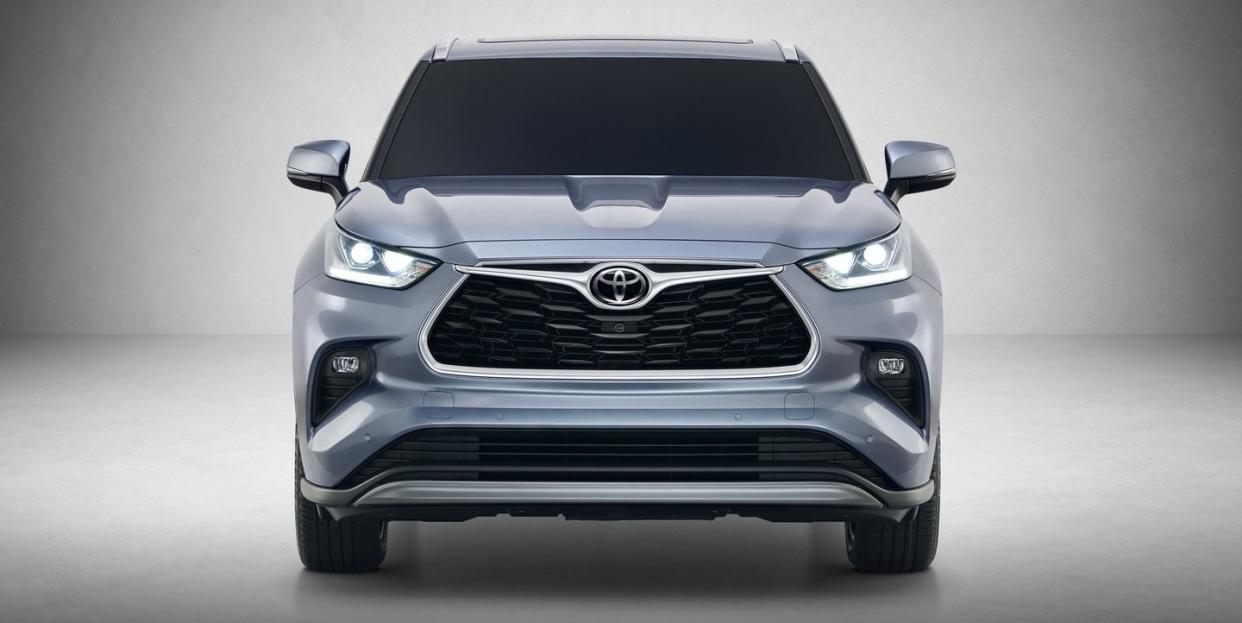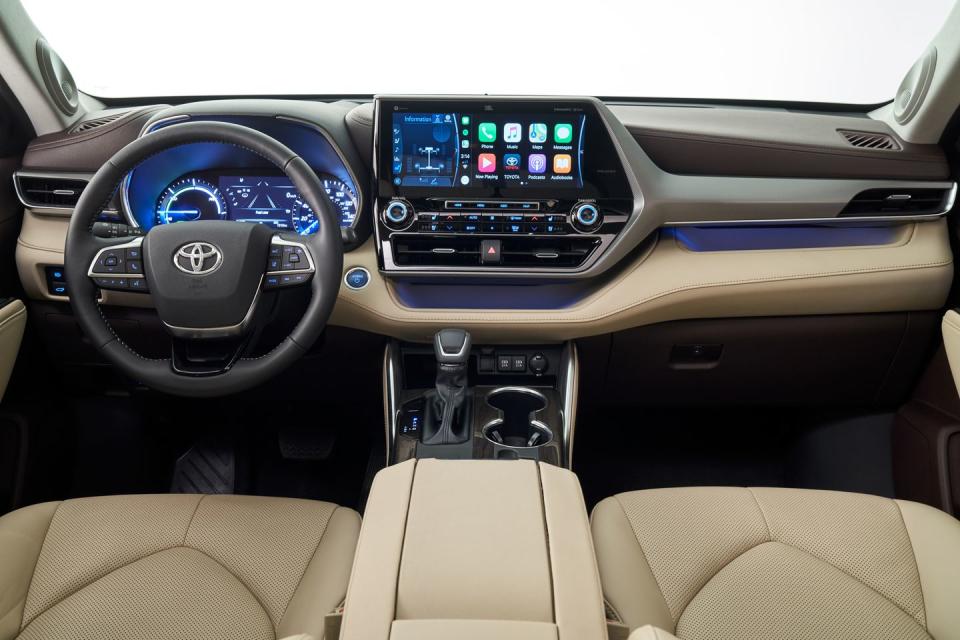The 2020 Toyota Highlander Is a More Chiseled Version of Itself

Toyota's Highlander SUV reaches its fourth generation without major changes, although it looks more rugged and angular.
Gasoline and hybrid versions are available as before, but the four-cylinder engine choice has been eliminated.
Technology, including new active-safety features, has been added to update the big SUV.
Based on Toyota’s New Global Architecture (TNGA-K), the fourth-generation Highlander emerges as a more sculpted and chiseled version of its former self. Still, it doesn’t deviate far from the inoffensive, three-row, room-for-the-whole-family-but-not-a-minivan formula that made it such a popular model in the first place. Now, it just looks squarer in the jaw while doing it.
Available in five trim levels-L, LE, XLE, Limited, and Platinum-the Highlander is once again available in gasoline and hybrid versions, although Toyota confirmed to C/D that the 2.7-liter inline-four engine has been dropped from the lineup.

Toyota says the new skin is more aerodynamic than the previous model which contributes to reduced wind noise and improves vehicle stability. Although the angular sheetmetal gives the new Highlander the appearance of a much larger vehicle, it is in fact only 2.4 inches longer overall than the previous Highlander, which means a total length of roughly 194.9 inches. Toyota hasn’t released any additional dimensional measurements. Thanks to the integrity of the TNGA-K platform, engineers were permitted to retune the front strut and rear multilink suspension for a smoother ride, a tighter turning radius, and increased agility.
Mild cosmetic details differentiate the trim levels: L, LE, and XLE trims feature a black front grille with silver trim, and the Limited and Platinum grades feature a black grille with chrome trim and a chrome-plated lower rear fascia, premium projector headlamps, and 20-inch alloy wheels, a Highlander first. The Platinum gets even more detail with a silver-painted front bumper and rear fascia and a new 20-inch wheel design. Five new exterior colors are added: Magnetic Gray Metallic, the blue-hued Moon Dust, Ruby Flare Pearl, Blueprint, and Opulent Amber, which is said to be a deep brown.
Traditional and Hybrid Powertrains
The 3.5-liter V-6 returns for an encore performance, cranking out the same 295 horsepower and 263 lb-ft of torque as it did in the previous Highlander, and an eight-speed automatic transmission handles the gear swaps. While not the most exciting combination, it is a proven entity. Toyota continues to offer the towing package with a heavy-duty radiator, an engine oil cooler, and improved fan performance; together they help the 2020 Highlander V-6 earn a 5000-pound tow rating. (Psst: That's the same as the previous model, but at least the update didn't negatively affect towing capability.) Toyota estimates a combined fuel economy number of 22 mpg for the V-6 Highlander.

While front-wheel drive is the standard setup, three different all-wheel-drive systems are available: L, LE, and XLE gas models utilize a proven system that can send up to 50 percent of the available torque to the rear wheels when slip is detected, while Limited and Platinum trims allow the buyer to select a newer setup that also can perform dynamic torque-vectoring duties. Controlled by an integrated management system that administers the throttle, transmission, power steering, and drive torque systems for optimized handling and traction, it can not only send torque to the rear wheels when needed, but also direct it to either the left or right wheel as the system identifies slip or to reduce understeer. The updated system on the Limited and Platinum trims also incorporates a rear driveline disconnect to reduce fuel consumption in situations such as highway driving.
Aside from the styling, the big Highlander news is the “New-Generation” Hybrid powertrain. A full technical dossier will have to wait until we test one, but basically the system is claimed to be smaller and lighter with fewer frictional losses. Available for the first time on either front- or all-wheel-drive models and on all trims except the base L, it utilizes a 2.5-liter DOHC four-cylinder engine teamed with a pair of electric motors for a total system output of 240 horsepower. The hybrid powertrain uses an independent rear-mounted electric motor that distributes torque to the rear wheels when it detects slip. New computer integration and a smaller, lighter power stack installed directly above the transaxle reduce energy transmission losses, and the battery pack is small enough to be installed under the rear seats without infringing on cargo or passenger space. Toyota says its estimated 34-mpg combined rating amounts to a 17 percent improvement in efficiency when compared with the previous Highlander hybrid’s 28-mpg combined rating. Part of the improvement can be accredited to the engine’s variable cooling system, which features an electrically driven water pump and thermostat to increase efficiency.
Toyota is claiming the system's overall operation has been refined as well, with efforts to keep engine speed closely synchronized with vehicle speed. Additionally, regenerative braking can be controlled via the sequential shifting feature which allows the driver to "downshift" in steps to maximize regeneration.
One interesting feature is the Highlander hybrid's Predictive Efficient Drive (PED) system, which analyzes data collected regarding the driver’s habits, routes, and road conditions to charge and discharge the battery in the most efficient and natural-feeling manner based on the gathered information. Sounds a little cryptic, but we’re interested to see how transparent it is in real-world operation.

There’s Safety, Space, and Entertainment Inside
Not surprisingly, the Highlander offers Toyota’s Safety Sense 2.0 suite of features as standard kit across the lineup. It includes adaptive cruise control, lane-departure alert with steering assist, automatic high-beams, and pre-collision with pedestrian detection. The suite also includes two features that are new to the Highlander and aptly named: lane-tracing assist and road sign assist. As you have likely surmised, the first item recognizes lane strips and helps keep you centered between them; the second can recognize road signs such as stop, yield, and speed limits and notify the driver, who apparently can't be bothered to pay attention, via visual or audible alerts. Blind-spot monitoring, rear cross-traffic alert, and an automated parking feature with brake assistance are available depending on the trim level.
The base L trim and next-step LE trim get a standard second-row bench that, combined with the third-row seat, makes the Highlander an eight-seater, while the XLE and Limited trims feature second-row captain’s chairs as standard but offer the bench as an option for those who absolutely need seating for eight. The Platinum gets the second-row captain's chairs and third-row bench as the sole seating arrangement for a maximum body count of seven. Standard three-zone climate control will keep the gang comfortable regardless of seating position. There’s 16.1 cubic feet of cargo space behind the third row, but folding it flat increases the cargo area to 40.6 cubic feet. Folding both second and third rows flat opens up 73.3 cubes for cargo duty. Compared to the outgoing Highlander, those figures represent increases of 2.3 (behind the third row) and 1.7 cubic feet (behind the second row), but a decrease of 10.4 cubic feet of total storage with both rows folded, according to official EPA cargo volume measurements.
Wisely, Toyota has equipped all trim levels of the 2020 Highlander with Apple CarPlay, Android Auto, and Alexa functionality along with Waze and SiriusXM satellite radio as standard equipment. Wi-Fi connectivity is available through AT&T as the provider. Infotainment functions are controlled through a standard 8.0-inch touchscreen, while the Platinum moves up to a 12.3-inch screen, and a 1200-watt, 11-speaker JBL audio system is standard on the Limited and Platinum models.
While the changes may seem incremental at best, Toyota knows not to mess with a proven concept, and the 2020 Highlander represents the same values as the previous editions in new, more contemporary wrapper.
('You Might Also Like',)

